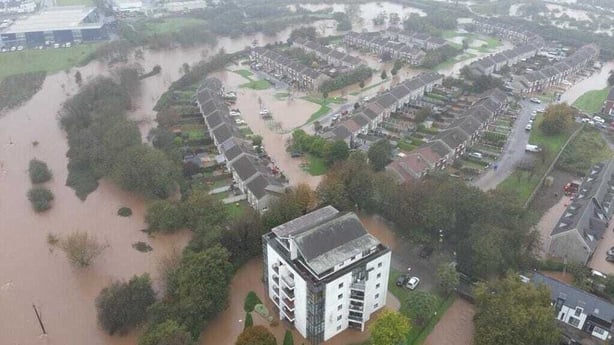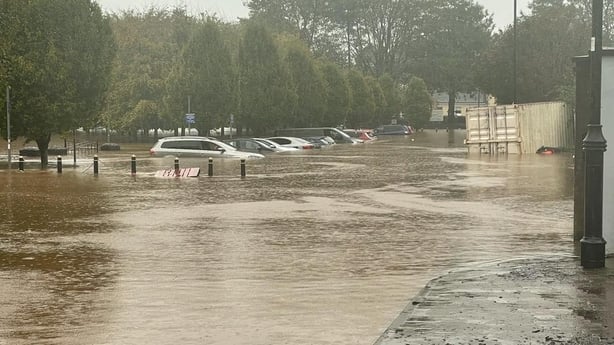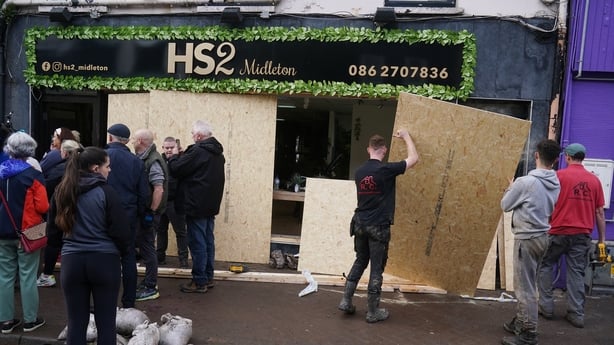If a person who lived in Midleton, Co Cork, in 1850 emerged today, they would find an unfamiliar climate in their locality.
That is what climate experts at the ICARUS Climate Research Centre in Maynooth University have concluded following very detailed analysis of historical observations from weather stations around the country.
The upshot of this analysis is that climate change is here right now in Ireland, and it looks exactly like the flooding and devastation experienced in Midleton earlier this week.
Meteorologists and climate experts are normally very coy about labelling any one weather event as the evidence of climate change.
Instead, they talk about the increasing likelihood of heavy rainfall or droughts or wildfires and highlight the probability of such events becoming more extreme.
It is quite rare, especially in Ireland, for them to produce weather data and results showing definitively that the extreme weather just experienced is actually climate change in action.
But that is where this new report, which is led by Prof Conor Murphy at Maynooth University, is different.
This is a piece of academic work, so it is a technical report, and it is a hard read. But those who struggle through it will be led to one firm conclusion.
Ireland is in trouble because climate change is now firmly upon us. The risk of flooding in our towns and villages and the misery and destruction that comes with it have soared.
We have not prepared well. Our flood prevention infrastructure is inadequate.
We are behind the curve when it comes to the engineering and nature-based solutions required to adapt and protect our towns and livelihoods.

The ICARUS research examines detailed weather-related measurements from a wide range of land-based weather stations around the country over the past 150 years.
It then uses these observations to create a set of indices to determine changes that have occurred in precipitation and warming.
They are looking for definitive signals that our climate has changed.
One of those indices is described as "a simple daily intensity index" of rainfall. This is the amount of rain we get each year divided by the number of days. The higher this index is, then the more intense is the rainfall.
The results show a very striking relationship has now emerged between rising global temperatures and rainfall in Ireland.
Specifically, it shows that the intensity of rainfall here is going up by 8.2% for every one-degree Celsius rise in global surface temperature.
Already the mean global surface temperature has risen by 1.1 degrees since pre-industrial times. So, according to this report, the intensity of the rainfall we saw this week and the havoc it wrecked on Midleton could be par for the course.
This is a remarkable finding, especially when one considers that the ultimate target of the Paris Climate Accord is to limit the rise in global temperatures to below 2C and to pursue all efforts to keep it below 1.5C.


In effect this means it would be a monumental global success if the rise in rainfall intensity in Ireland could be kept below 17%. And that is just the average.
Remember too, that so far there is no sign the world is on track to achieve that 2C warming limit.
Imagine what that might mean for towns like Midleton and other towns that are even more exposed.
For instance, this ICARUS analysis shows rainfall intensity at the Kilkenny-Lavistown weather station is increasing at a rate of 13.7% for every 1C of global warming.
This is a terrifying prospect for business and homeowners alike especially in areas of the country where investment in flood prevention infrastructure is lacking.
The nearest Met Éireann weather station to Midleton is located at Roches Point, Co Cork - about 12km away as the crow flies.
Roches Point is specifically identified in the ICARUS report as one of the weather stations with the fingerprints of climate change all over it.
It says that out of all the weather stations analysed the increase in "autumn warm days" is greatest at Roches Point and is rising by 11.9% for every 1C increase in global temperature. The rainfall intensity at Roches Point is also specifically highlighted as "unusual" relative to our early industrial climate.
Other places are in danger too. Take Malin Head for instance. This report reveals winter rainfall there is going up by 25.2% for every 1C of global warming.
Measurements at the Met Éireann's Markree weather station in Sligo show winter rainfall there is rising at a rate of 19.2% for every 1C of global warming.
In statement about these findings, Prof Murphy said that human driven climate change is now clearly discernible in Irish weather records.
Of the 903 climate indicators analysed across the study, 37% show the emergence of conditions we would consider at least "unusual" relative to early industrial or natural climate.
"These results clearly tell us that adaptation to the impacts of climate change needs to be given greater emphasis in national and local climate policy," he said. "Climate change is here, and it is evident in our climate observations."

All of this serves to say that the flood devastation experienced by the townsfolk of Midleton is unlikely to be an isolated incident.
Ireland is behind the curve when it comes to adapting our towns and villages, our homes and businesses, to the impact of what is happening before our eyes.
The Government is due to update our five-year-old National Adaptation Framework before the end of this year. This is the document that sets out the plan of action for investment in flood defences, both natural and engineered, as well as a wide range of other measures to ensure we can live with the challenges climate change will bring.
But the point is that climate change is not something for the future. Rather it is something we must deal with right now.
The catastrophic flooding and misery in Midleton earlier this week underscore how important it is that local authorities and government policymakers wake up, recognise how vulnerable we are, especially to flooding, and accelerate all the measures necessary to protect homes, businesses, and livelihoods.
There are many people who think it is no longer good enough for official Ireland to hide behind delays in our planning system while rainfall intensity here is rising by 8.2% for every 1C of global warming.
The academic paper by Prof Murphy and colleagues is called "The emergence of a climate change signal in long-term Irish meteorological observations".
It is published in the scientific Journal Weather and Climate Extremes and can be accessed here.








